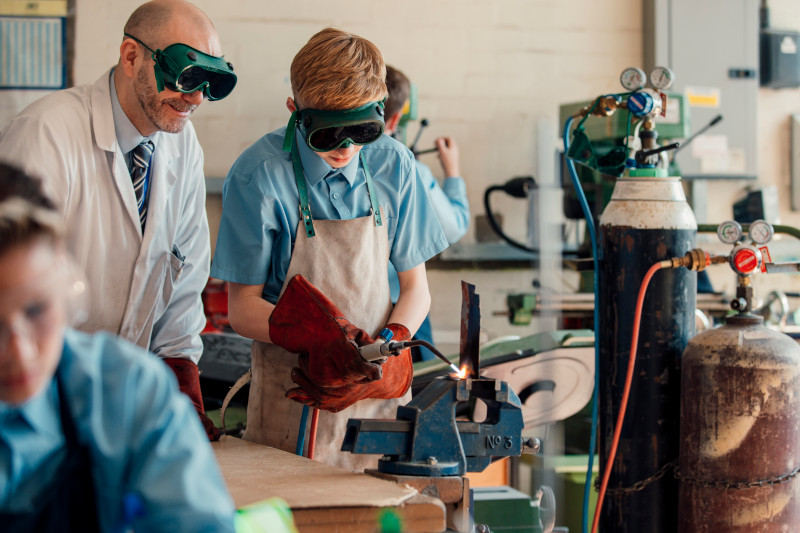Keep an eye (and ear) out for safety

March is Workplace Eye Wellness Month, and World Hearing Day is also observed this month. With that in mind, let’s look at some ways you can protect the eyes and ears of your school staff and students.
The places with the greatest risks to eyes and hearing are in your vocational shops and maintenance areas. Typical hazards that may be encountered in various workplace settings include:
- Flying debris/particles.
- Chemical contact/exposure (i.e., splashes, burns, inhalation, irritation).
- Intense light (i.e., lasers, welding).
- Noise exposure.
Make sure these basic safety tips are being addressed:
- Hearing and eye protection should always be provided and enforced when completing tasks with exposure to noise or eye hazards exists.
- Welding curtains should be provided to shield others working in the area from ultraviolet radiation and reduce the risk of “weld flash” eye injuries.
- Vocational education instructors should provide training on any shop equipment prior to use.
- Proper eye protection and/or face shields should be used when operating equipment (the specific eye protection required is dependent on the type of hazard exposure).
- All equipment should be equipped with machine guards, which provide a barrier between an individual and the point of operation, power train or moving components.
- All equipment should be inspected by the user before use for defects that may cause injury. This may include damaged cords or missing machine guards, to name a few.
- Long loose hair, jewelry or articles of clothing should not be worn when operating equipment.
The importance of proper personal protective equipment (PPE)
Following other safety precautions, personal protective equipment (PPE) is the last line of defense against a multitude of hazards that can be encountered in the school setting. PPE includes gloves, masks, safety glasses/eyewear, hearing protection or other items worn to provide protection. Most types of PPE, including eye protection, conform to or meet standards set by the American National Standards Institute (ANSI).
To make sure staff and students are using it as intended, PPE should fit properly and be comfortable to wear. Consider this scenario: A student is working on a project in the vocational education laboratory, but none of the safety glasses provided by the school fit them properly. The student foregoes eye protection for the sake of comfort and gets injured; the school is now liable.
To allow users to choose what works best for them, have a variety of shapes, sizes and styles of PPE equipment like glasses and ear plugs available. Gain end user input on which types of materials and equipment are best suited for work in real world applications. Any individual wearing PPE should be trained in the proper use, care and limitations of the PPE before use to avoid unnecessary injury.
Eye strain
Even those who don’t work around the risks of immediate eye injuries can have their vision impacted by eye strain. This can come from excessive time on a computer or from working in improperly lit conditions. Eye strain can cause physical and mental fatigue, blurred vision, light sensitivity, dry/itchy eyes and headaches. Preventing those issues can start with a work area assessment and making the necessary changes.
- Take breaks! For every hour of screen time, a break lasting at least five minutes can help with visual and mental fatigue.
- Follow the 20-20-20 rule. After 20 minutes of screen use, focus on an object approximately 20 feet away for 20 seconds. This allows your eyes to readjust and get some relief.
- Be sure to have your eyes checked on a routine basis. The lack of proper prescription eyewear can increase the amount of stress on your eyes while trying to focus.
- Avoid scratching or rubbing your eyes. Instead, splash your face with clean, cold water to help provide relief.
- Set up your workstation to avoid glare from lighting sources or windows.
- Overhead/area lighting should always be diffused to help reduce glare and an overabundance of light that can be strenuous on the eyes.
- Use local lighting for specific tasks at your desk to allow enough visibility; however, make certain it is not so bright that it increases the stress on your eyes.
- Use natural lighting from windows whenever possible, making sure it does not create glare on a computer screen or is directly facing an employee at their workstation.
With a variety of risks to eyes and hearing in the school setting, it’s vital to keep safety top of mind. The responsibilities to mitigate these risks are shared by students, administrators, teachers and maintenance personnel. For more risk control tips on eye safety you can find additional resources here.




